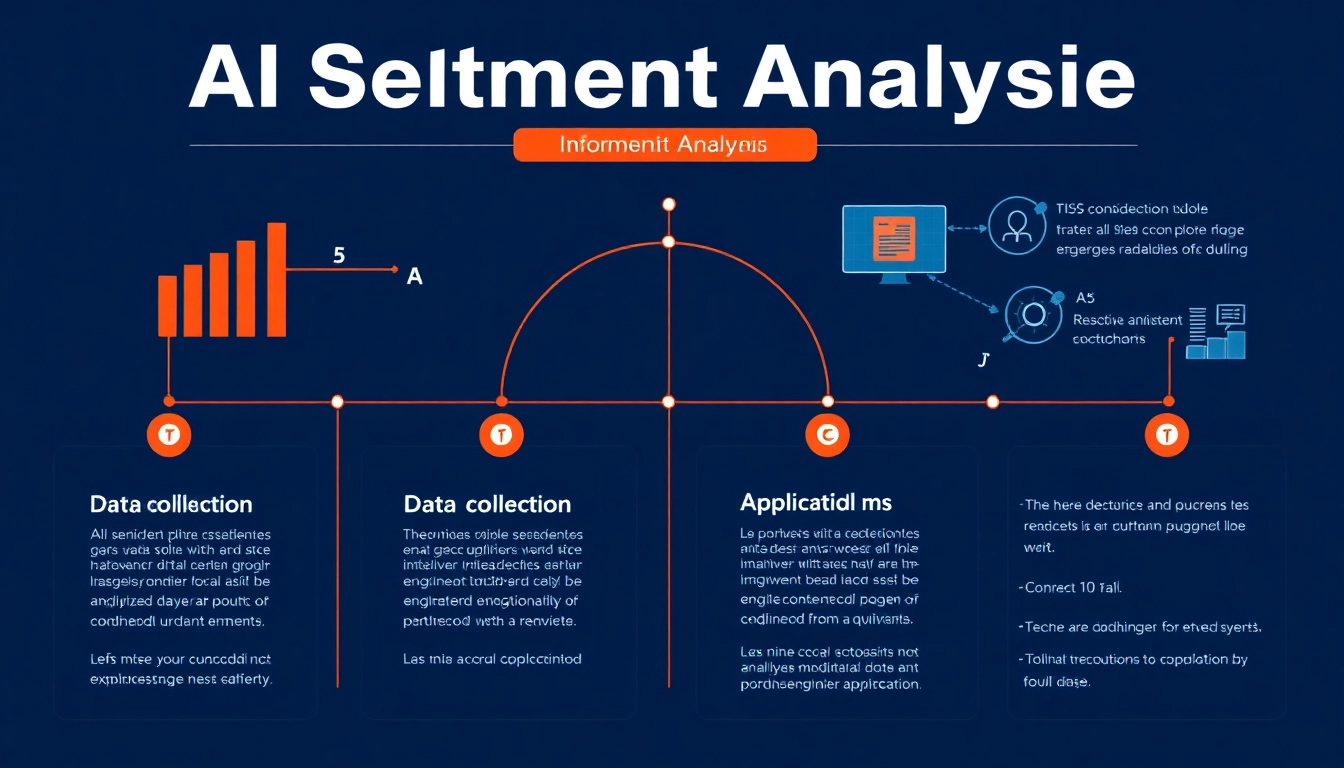Introduction to AI Sentiment Analysis
AI sentiment analysis is a revolutionary technology that enables computers to identify and interpret human emotions embedded in text. As businesses increasingly leverage data to drive decisions, understanding consumer sentiment becomes critical. This analysis involves the use of sophisticated algorithms and methodologies to distill feelings from vast amounts of unstructured data, contributing to insights that shape strategies and enhance customer engagement. By integrating AI sentiment analysis into their systems, organizations can automate the emotional assessment of customer feedback across numerous platforms, making proactive adjustments to their offerings and marketing approaches.
Definition and Purpose of Sentiment Analysis
Sentiment analysis, often referred to as opinion mining, is a computational method that analyzes texts to determine their emotional tone. This includes distinguishing whether the sentiment of a piece of content is positive, negative, or neutral. Historically, businesses relied on qualitative methods to understand customer feelings. However, the evolution of AI technologies has introduced more efficient and scalable options. The primary purpose of sentiment analysis is to quantify subjective data which can be pivotal in providing insights for decision-making processes across various sectors such as marketing, customer service, and product development.
Importance in Modern Data Interpretation
In the age of information overload, companies are inundated with data from customer reviews, social media, and other digital communications. This vast volume of information can overwhelm traditional data analysis methods. AI sentiment analysis plays a crucial role in sifting through this data, enabling organizations to extract meaningful insights about public perception and consumer behavior. By understanding sentiment, businesses can tailor their products and services based on customer needs, enhance user experiences, and predict trends in public opinion, thereby gaining a substantial competitive edge in the market.
Overview of the AI Sentiment Analysis Process
The process of AI sentiment analysis typically involves several steps. First, data collection occurs, gathering text from various sources such as social media, blogs, reviews, and customer feedback. Next, the data is preprocessed to remove noise, such as irrelevant information and formatting issues. Key techniques such as tokenization, stemming, and lemmatization are employed to break down the text further and standardize terms. Following this, natural language processing (NLP) algorithms classify the sentiment, which may utilize machine learning to continuously improve accuracy through training on labeled datasets. Finally, the outputs are analyzed, providing actionable insights for businesses.
Key Techniques in AI Sentiment Analysis
Natural Language Processing (NLP) Applications
Natural Language Processing (NLP) is the backbone of AI sentiment analysis, enabling machines to understand and interpret human language. Several techniques within NLP enhance sentiment analysis, such as:
- Tokenization: Splitting text into smaller units called tokens (words or phrases) to facilitate easier analysis.
- Part-of-Speech Tagging: Identifying grammatical elements within sentences, helping to understand the structure of sentiments.
- Sentiment Lexicons: Utilizing predefined lists of words associated with emotional valences, aiding algorithms in determining sentiment polarity.
- Named Entity Recognition: Identifying specific entities (people, organizations, locations) that may contribute to the sentiment of the text.
- Dependency Parsing: Analyzing grammatical structure and relationships between words to better understand context.
Machine Learning Algorithms for Enhanced Accuracy
To refine sentiment analysis capabilities, various machine learning algorithms are employed. Popular methods include:
- Supervised Learning: Algorithms are trained on labeled datasets, learning to classify sentiments based on features extracted from the data. Common models include Naïve Bayes, Support Vector Machines (SVM), and Decision Trees.
- Deep Learning: Leveraging complex neural networks, such as Long Short-Term Memory (LSTM) and Convolutional Neural Networks (CNN), to capture intricate patterns and nuances in data. These methods are particularly effective for large datasets.
- Reinforcement Learning: Used to improve sentiment analysis models progressively by training them on feedback, enabling the system to learn from previous mistakes.
Sentiment Classification Techniques
Sentiment classification is pivotal to understanding and quantifying emotional responses in texts. Various techniques include:
- Binary Classification: Classifies sentiments into two categories – positive or negative. This simplistic approach is often used in applications requiring a basic understanding of customer feelings.
- Multiclass Classification: Expands sentiment classification into multiple categories, including neutral, positive, and negative, providing a more comprehensive view of consumer sentiment.
- Fine-grained Sentiment Analysis: Goes even further by assigning scores to sentiments on a perceptual scale (e.g., from -1 to 1), reflecting the strength of emotional responses.
Real-World Applications of AI Sentiment Analysis
Use Cases Across Different Industries
AI sentiment analysis has transformed numerous industries by providing them with tools to understand customer sentiment effectively. Examples include:
- Marketing: Brands utilize sentiment analysis to gauge consumer reactions to campaigns, products, or services, allowing for real-time adjustments to strategies.
- Finance: Traders and financial analysts analyze sentiments from news articles and social media to make informed decisions about stock movements.
- Healthcare: Patient feedback on social media and surveys is analyzed to improve service delivery and patient care experiences.
- Public Relations: Organizations monitor public sentiment regarding their brand image and reputation, assisting in crisis management and reputation repair.
ROI and Strategy Impact of Sentiment Analysis
The integration of AI sentiment analysis can lead to significant ROI for organizations. Companies using sentiment analysis have reported:
- Enhanced customer satisfaction through responsive service improvements based on feedback analysis.
- Increased engagement rates in campaigns by optimizing content based on sentiment insights.
- Better product development cycles informed by consumer preferences and emotional reactions to past launches.
Firms that thoroughly integrate sentiment analysis into their strategic planning tend to outperform competitors in customer relationship management and market positioning.
Customer Behavior Insights
Understanding customer behavior is pivotal for any business aiming to develop long-lasting relations with its clientele. AI sentiment analysis aids in uncovering actionable insights by revealing not just how customers feel about a brand but also why they may feel that way—a crucial distinction. By analyzing reviews, feedback, and social media interactions, businesses can:
- Identify trends in customer preferences and behaviors.
- Understand which factors drive positive or negative sentiments (e.g., product features, pricing, customer service).
- Segment audiences based on emotional responses, allowing for tailored marketing approaches.
Challenges in AI Sentiment Analysis
Identifying Ambiguity in Language
Human language is inherently ambiguous, filled with slang, idioms, sarcasm, and varying expressions of emotion. This complexity poses significant challenges for AI sentiment analysis:
- Context Sensitivity: Words can have different meanings depending on their context. For example, “sick” can convey approval in certain slang contexts but is negative in a health context. AI models must be trained on diverse datasets to interpret these variances accurately.
- Subtlety in Sentiment: Detecting sarcasm and nuanced emotions is difficult for machines, often leading to misclassification. Developing models that can understand subtle cues requires extensive training and advanced NLP techniques.
Data Quality and Volume Considerations
The effectiveness of AI sentiment analysis is highly dependent on the quality and volume of data inputs. Challenges here include:
- Data Noise: Irrelevant or poorly formatted data can skew analysis results. Implementing thorough preprocessing techniques is essential to stratify messages effectively.
- Training Data Bias: If the training dataset is unbalanced or not diverse enough, the model may perform poorly on new, unseen data or only represent specific demographics.
Maintaining Contextual Understanding
Ultimately, maintaining contextual understanding is crucial for the success of sentiment analysis. AI systems must be designed to capture the emotional tone accurately within various contexts—such as understanding the circumstances behind customer complaints versus compliments. Techniques to address this include:
- Utilizing Additional Data Sources: Combining sentiment analysis with demographic insights and behavioral analytics can provide a more comprehensive understanding of the context.
- Feedback Loops: Implementing systems that allow algorithms to learn continuously from user feedback to refine sentiment classification.
Future Trends in AI Sentiment Analysis
Emerging Technologies and Innovations
The future landscape of AI sentiment analysis is poised for growth, driven by emerging technologies that enhance precision and applicability. Key trends include:
- Integration of Voice Analysis: As voice-activated digital assistants become ubiquitous, analyzing spoken sentiments will gain traction, helping to capture nuances lost in written text.
- Real-time Sentiment Tracking: Advancements in processing power will enable real-time sentiment analysis on vast datasets, vastly improving customer responsiveness.
- Multimodal Sentiment Analysis: Integrating analysis across text, audio, and visual data to provide a complete perception analysis for richer insights.
Integration with Other AI Disciplines
AI sentiment analysis is increasingly being integrated with other AI disciplines, enhancing its effectiveness. Collaborations between sentiment analysis and:
- Machine Learning: Continuous learning systems that adapt sentiment analysis models based on new data and feedback.
- Predictive Analytics: Combining historical sentiment trends with predictive analysis to foresee customer reactions to market shifts.
- Generative AI: Utilizing generative models to craft tailored responses based on emotional insights derived from sentiment analysis.
Predictions for Market Adoption and Growth
The market for AI sentiment analysis is expected to expand significantly in the coming years, driven by demands for improved customer engagement and data-driven strategy formulation. Key predictions include:
- A surge in demand for affordable, user-friendly sentiment analysis tools tailored for small and medium-sized enterprises.
- Increased implementation of sentiment analysis in crisis management, ensuring organizations can respond promptly to negative sentiment.
- Prospective regulatory frameworks that shape how data is used for sentiment analysis, emphasizing ethical considerations in data usage.


